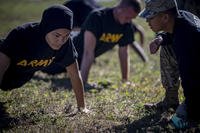Continuing to run or never running again is an easy decision for many, as running is not particularly fun or easy for non-running athletes, heavier people and those of us aging into our 50s and 60s and beyond.
However, if you want to continue running, some options will help you continue running or walking and supplement it with less impactful cardio events.
Here is a question from a veteran nearing his 40s:
Stew, I have been doing your workouts for some time -- the calisthenics book now. Does running ever get easier or more enjoyable? My legs and feet usually hurt. It's not soreness. I stretch, foam roll, and utilize mobility day too each week though I still hate running. I'm not yet 40, and there's already a little arthritis in my feet. Not sure if this is part of my problem. I don't know. With all the people you train, maybe one person has had similar issues. Thanks, Jonathan
Jonathan, thanks for the email. Most people have to weigh the pros and cons of running as they age. Consider the following options either to assist with your running or supplement it with other cardio activities:
You Can Still Run, But ...
Do not be so rigid in thinking you need to continue running at any age. Depending on the issue, you may be better off doing other equally challenging cardio events. Swimming, rowing and biking are tough and work the heart, lungs and muscles even better than running alone.
Learning how to do some other cardio options should be on your training agenda during the next decade. You may find 10-15 years from now that you will need to resort to less impactful ways to maintain cardiovascular health.
Mix in More Non-Impact Cardio
Though I still run in my 50s now, I mix in just about as much nonimpact cardio, so my week is about 50% running and 50% biking and swimming. I call this my triathlon model for running. You could make running, biking and swimming (or another nonimpact cardio) 33% of your total cardio activity each week.
Having two-thirds of your cardio being nonimpact is my first recommendation. Walking is acceptable in place of running as well if the impact of running hurts anything from your feet to your lower back.
Find Softer Ground for Running
Consider running on turf, grass, a rubberized track, soft sand beach or trails. Stay off pavement and concrete as much as possible. This has also been helpful as I continue to run in my 50s (weighing more than 200 pounds.).
Another option is running on the inside grass or rubberized turf section when you do track workouts to make it even less impactful than the track. If you like to progress to 10-20 miles per week of running, I would do softer ground running.
Lose Weight
Running lighter is just easier, and being closer to your natural height/weight recommendations is healthier for your heart, joints and health screening blood work. Consider a round of tests to work on getting your personal bests: body weight, blood pressure, cholesterol, triglycerides, etc.. PR-ing on my annual physical/health screening is something I enjoy as much as training itself.
Never Skip Mobility Day
That has been the one addition to my week that has made me feel good enough to run. Massage or stretch your feet, knees, hips, lower back and muscles regularly to help with any typical running aches and pains.
Five minutes of cardio, followed by five minutes of stretching or foam rolling for 30-60 minutes, is life-changing -- seriously. I think this addition alone allowed me to feel better running throughout my 40s and into my 50s now.
Diversity is the key to keeping moving. Don't be stuck with just walking or running; search for other healthy options that will help sustain you if the aches and pains of gravity start to affect your ability to run.
Stew Smith is a former Navy SEAL and fitness author certified as a Strength and Conditioning Specialist (CSCS) with the National Strength and Conditioning Association. Visit his Fitness eBook store if you're looking to start a workout program to create a healthy lifestyle. Send your fitness questions to stew@stewsmith.com.
Want to Learn More About Military Life?
Whether you're thinking of joining the military, looking for fitness and basic training tips, or keeping up with military life and benefits, Military.com has you covered. Subscribe to Military.com to have military news, updates and resources delivered directly to your inbox.



















